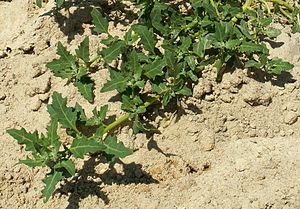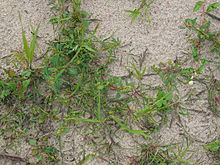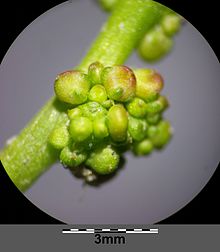Gray-green goosefoot
| Gray-green goosefoot | ||||||||||||
|---|---|---|---|---|---|---|---|---|---|---|---|---|

Gray-green goosefoot ( Oxybasis glauca ) |
||||||||||||
| Systematics | ||||||||||||
|
||||||||||||
| Scientific name | ||||||||||||
| Oxy base glauca | ||||||||||||
| ( L. ) S. Fuentes , Uotila & Borsch |
The gray-green goosefoot ( Oxybasis glauca , Syn .: Chenopodium glaucum ) is a species of the subfamily Chenopodioideae in the foxtail family (Amaranthaceae). It occurs in Europe, Asia and North America.
description
Vegetative characteristics
The gray-green goosefoot is an annual herbaceous plant and usually reaches heights of 20 to 40 cm, rarely up to 120 cm, but mostly it grows characteristically prostrate and only a few centimeters high. The mostly creeping stem is green to purple-red and ribbed.
The alternate leaves are divided into a petiole and a leaf blade. The petiole is 5 to 10 mm long. The leaf blade, which is often fleshy, has a length of 2 to 4 cm and a width of 0.6 to 2 cm. The upper side of the leaf is bare and dark gray-green, the underside of the leaf is very white-gray floury. The leaf margins are dentate to lobed. The protruding middle nerve is yellow-green.
Generative characteristics
The composite total inflorescences consist of clustered partial inflorescences. There are hermaphrodite and female flowers. The light green flower envelope is three to five lobed. The one or two stamens do not protrude beyond the inflorescence and have spherical anthers. The two scars are very short.
The membranous pericarp is yellow-white. The dark brown or red-brown, flattened spherical seeds have a diameter of about 0.75 mm. The seed coat is finely dotted with pitted to net-veined.
The number of chromosomes is 2n = 18, some studies also found 2n = 36.
ecology
The gray-green goosefoot is a food plant for the butterfly caterpillars of goosefoot moth ( Eupithecia sinuosaria ) and moth leaf moth ( Pelurga comitata ).

Distribution and location requirements
The gray-green goosefoot is Eurasian- continental spread. It occurs in large parts of Europe , in the temperate zones of Asia to East Asia and in North America .
In Germany, it grows particularly in summery, annuell- dominated goosefoot banks ( Chenopodion rubri ) .
Furthermore, it thrives less frequently in the young phases (initial stage) of nitrogen-rich ruderal corridors and in weed corridors ( Polygono-Chenopodietalia ) of root crop fields and gardens, especially in village settlements, on dung sites, gutters, ditches, walls and garbage dumps. As a salt-bearing species, it can also occasionally be found in salt plant corridors . In the Allgäu Alps, it rises between the Upper Balderschwanger Alpe and the Speicherhalden-Alpe up to 1420 m above sea level.
Systematics
Oxybasis glauca (L.) S. Fuentes, Uotila & Borsch belongs to the tribe Atripliceae in the subfamily Chenopodioideae within the family Amaranthaceae .
It was first described as Chenopodium glaucum in 1753 by Carl von Linné in Species Plantarum . Molecular genetic studies revealed that the species does not belong to Chenopodium in the narrower sense. Therefore, it was placed in the genus Oxybasis by Suzy Fuentes-Bazan , Pertti Uotila and Thomas Borsch in 2012 .
Synonyms for Oxybasis glauca (L.) S. Fuentes, Uotila & Borsch , which are based on the same type specimen, are Chenopodium glaucum L. , Agathophytum glaucum (L.) Fuss , Atriplex glauca (L.) Crantz (nom. Illeg.), Blitum glaucum (L.) WDJ Koch , Botrys glauca (L.) Nieuwl. , Chenopodium glaucum subsp. euglaucum (L.) Aellen (nom inval.) and Orthospermum glaucum (L.) Opiz . As more synonyms are Chenopodium ambiguum R.Br. , Chenopodium ambiguum var. Majus Moq. , Chenopodium ambiguum var. Minus Moq. , Chenopodium glaucum var. Ambiguum (R.Br.) Hook.f. , Chenopodium glaucum subsp. ambiguum (R.Br.) Murr & Thell. , Chenopodium glaucum var. Divaricatum Hook.f. , Chenopodium glaucum var. Divaricatum Moq. , Chenopodium glaucum var. Littorale Rodway , Chenopodium glaucum subsp. marlothianum Thell. & Aellen , Chenopodium glaucum f. minus (Moq.) Aellen , Chenopodium littorale Moq. (nom. illeg.), Chenopodium nudiflorum F. Muell. ex Murr , Chenopodium pallidum Moq. , Chenopodium wolffii Simonk. and Orthosporum glaucum Peterm. Some subspecies or varieties have been described, this is discussed differently by authors.
swell
- Steven E. Clemants, Sergei L. Mosyakin: Chenopodium . In: Flora of North America Editorial Committee (Ed.): Flora of North America North of Mexico . Volume 4: Magnoliophyta: Caryophyllidae, part 1 . Oxford University Press, New York / Oxford a. a. 2003, ISBN 0-19-517389-9 , Chenopodium glaucum , p. 283 (English, online ). (Sections Description and Systematics)
- Gelin Zhu, Sergei L. Mosyakin, Steven E. Clemants: Chenopodium . In: Wu Zhengyi, Peter H. Raven, Deyuan Hong (Eds.): Flora of China . Volume 5: Ulmaceae through Basellaceae . Science Press / Missouri Botanical Garden Press, Beijing / St. Louis 2003, ISBN 1-930723-27-X , Chenopodium glaucum , pp. 379 (English, online ). (Sections Description and Systematics)
- Gray-green goosefoot. In: FloraWeb.de.
- Rudolf Schubert, Walter Vent (Ed.): Excursion flora from Germany. Founded by Werner Rothmaler. 8th edition. Volume 4: Critical Volume, People and Knowledge, Berlin 1990. ISBN 3-06-012526-0 .
Individual evidence
- ↑ a b c d Susy Fuentes-Bazan, Pertti Uotila, Thomas Borsch: A novel phylogeny-based generic classification for Chenopodium sensu lato, and a tribal rearrangement of Chenopodioideae (Chenopodiaceae) . In: Willdenowia. Volume 42, No. 1, 2012, pp. 5–24 (here: p. 15), DOI: 10.3372 / wi.42.42101 .
- ^ A b Oxybasis glauca in the Germplasm Resources Information Network (GRIN), USDA , ARS , National Genetic Resources Program. National Germplasm Resources Laboratory, Beltsville, Maryland.
- ↑ Gray-green goosefoot. In: FloraWeb.de.
- ↑ Chenopodium glaucum , chromosome number at Tropicos.org. Missouri Botanical Garden, St. Louis
- ^ Gaden S. Robinson, Phillip R. Ackery, Ian J. Kitching, George W. Beccaloni, Luis M. Hernández: Entry at HOSTS - A Database of the World's Lepidopteran Hostplants .
- ↑ Erich Oberdorfer : Plant-sociological excursion flora . With the collaboration of Theo Müller. 5th, revised and expanded edition. Eugen Ulmer, Stuttgart (Hohenheim) 1983, ISBN 3-8001-3429-2 , pp. 345 .
- ↑ Erhard Dörr, Wolfgang Lippert : Flora of the Allgäu and its surroundings. Volume 1, IHW, Eching 2001, ISBN 3-930167-50-6 , p. 459.
- ↑ Carl von Linné: Species Plantarum. Volume 1, Lars Salvius, Stockholm 1753, p. 220 digitized
- ↑ Chenopodium glaucum at Tropicos.org. Missouri Botanical Garden, St. Louis, accessed January 27, 2012.
- ^ Entry in The Plant List , accessed January 27, 2012
Web links
- Gray-green goosefoot. In: FloraWeb.de.
- Distribution map for Germany. In: Floraweb .
- Chenopodium glaucum L. In: Info Flora , the national data and information center for Swiss flora .
- Distribution in the northern hemisphere from: Eric Hultén, Magnus Fries: Atlas of North European vascular plants. 1986, ISBN 3-87429-263-0 at Den virtuella floran. (swed.)
- Thomas Meyer: Data sheet with identification key and photos at Flora-de: Flora von Deutschland (old name of the website: Flowers in Swabia )
- Günther Blaich: Photos of European plants. Chenopodium glaucum.




